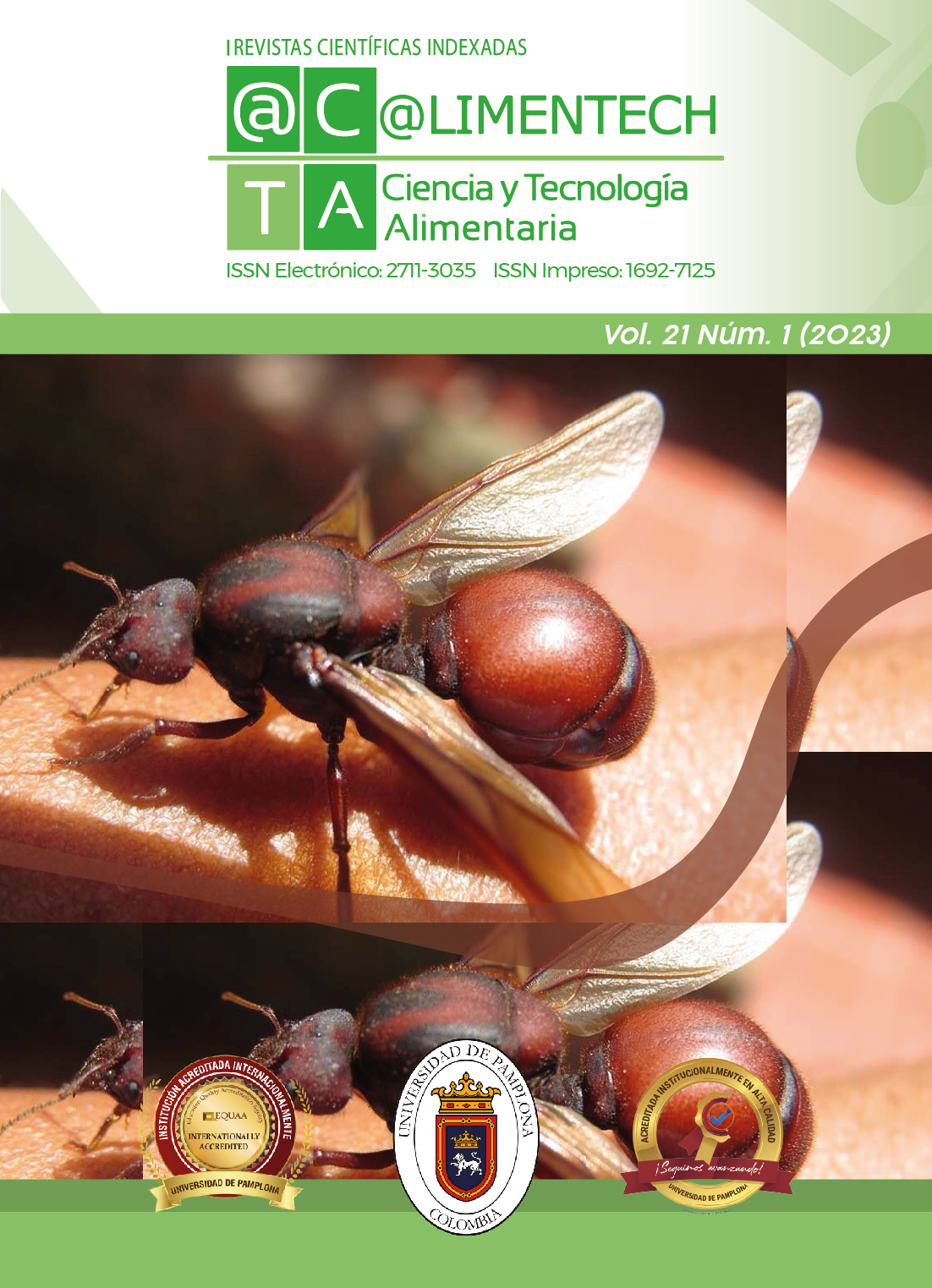Nutritional properties of the santandereana ant (atta laevigata)
DOI:
https://doi.org/10.24054/limentech.v21i1.2332Keywords:
New processes, use of resources, Ant, nutritional compositionAbstract
The Santanderean ant (Atta Laevigata), lives in some regions of the departments of Colombia, particularly those of Santander and Casanare, this species is used as a food source by the populations of these areas. Therefore, the nutritional composition of this species was evaluated, the results show contents of fat 20.45 g / 100 g, protein 22.5 g / 100 g, humidity 40.42 g / 100 g, ash 1.01 g / 100 g, cobalt 0.20 ppm, iron 0.08 g / 100 g, calcium 0.06 g / 100 g, potassium 0.36 g / 100 g and magnesium 0.19 g / 100 g, the characterization of methylated fatty acids (FAME), were determined by gas chromatography and the major components were: Oleic acid 45.55 g/100 g, alpha linolenic acid 20.25 g/100 g, myristic acid 16.59 g/100 g, palmitic acid 7.44 g/100 g, linolenic acid 6.49 g/100 g, gamma linoleic acid 3.39 g/100 g and EPA 2.26 g / 100 g, evidencing a high nutritional contentDownloads
References
Coronado, M., Vega, S., Gutiérrez, R., García, B., & Díaz, G. (2006). Los ácidos grasos omega-3 y omega-6: nutrición, bioquímica y salud. REB, 25(3), 72-79.
FAO. (2010). Forest insects as food: humans bite back. Bangkok.
FAO. (2013). Future prospects for food and feed security. Disponible en www.fao.org/forestry/edibleinsects/en/
Granados, C., Acevedo, D., & Guzmán, L. (2013). Tostado y harina de la hormiga Santandereana "atta laevigata". Biotecnología en el Sector Agropecuario y Agroindustrial, 11(1), 68-74.
Hernández, O., Aldama, R. G., & Díaz, A. J. (2004). Insectos Comestibles. Centro de Investigaciones Biológicas de la Universidad Autónoma del Estado de Morelos. http://hypatia.morelos.gob.mx/no4/insectos_comestibles.htm Accesado: 17 febrero 2022.
Landero, T. I., Murguia, G. J., & Ramos, E. J. (2005). Estudio etnográfico sobre el consumo de las “chicatanas” (Hymenoptera: Formicidae) en Huatusco, Veracruz, México. Folia Entomológica Mexicana, 44(002), 109-113.
Morillas-Ruiz, J. M., & Delgado-Alarcón, J. M. (2012). Análisis nutricional de alimentos vegetales con diferentes orígenes: Evaluación de capacidad antioxidante y compuestos fenólicos totales. Nutr. clín. diet. hosp, 32(2), 8-20.
Ramos-Elorduy, J., & Viejo-Montesinos, J. L. (2007). Los insectos como alimento humano: Breve ensayo sobre la entomofagia, con especial referencia a México. Bol. R. Soc. Esp. Hist. Nat. Sec. Biol, 102(1-4), 61-84.
Rueda, E. D., & Stashenko, E. (2004). Extracción y análisis de ácidos grasos presentes en la hormiga "Culona" (Atta laevigata). Tesis de Química, Universidad Industrial de Santander –UIS-, Colombia.
Sánchez-Peña, S. (2005). New view on origin of Attine ant–fungus mutualism: Exploitation of a preexisting insect–fungus symbiosis (Hymenoptera: Formicidae). Annals of the Entomological Society of America, 98(2), 151–164.
Torrenegra, M., Granados, C., Osorio, M., & León, G. (2015). Method comparison of hydrodistillation microwave radiation-assisted (MWHD) front hydrodistillation (HD) in the extraction of essential oil of Minthostachys mollis. Inf. Tecnol, 26(1), 117-122.
Downloads
Published
How to Cite
Issue
Section
License
Copyright (c) 2023 @limentech, Ciencia y Tecnología Alimentaria

This work is licensed under a Creative Commons Attribution-NonCommercial 4.0 International License.








